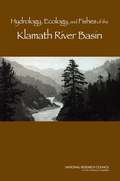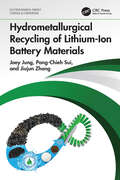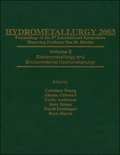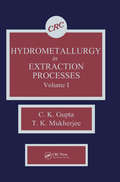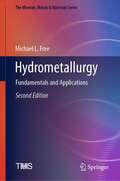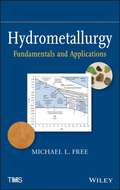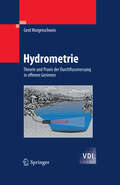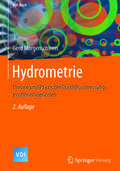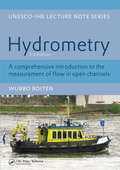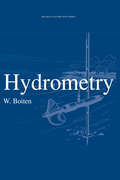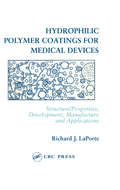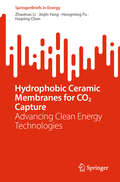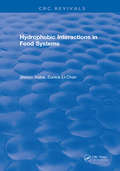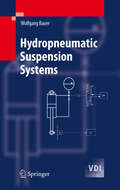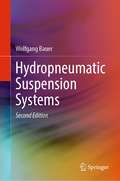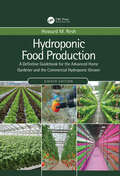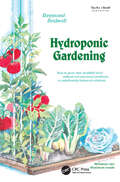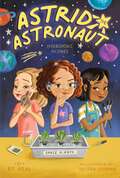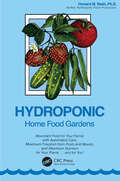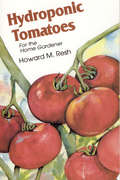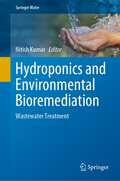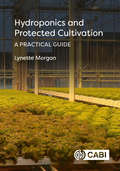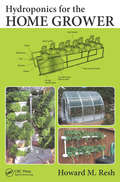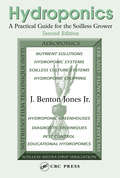- Table View
- List View
Hydrology, Ecology, and Fishes of the Klamath River Basin
by National Research Council of the National AcademiesThe Klamath River basin, which spans parts of southern Oregon and northern California, has been the focus of a prominent conflict over competing uses for water. Management actions to protect threatened and endangered fish species in the basin have left less water available for irrigation in dry years and heightened tensions among farmers and other stakeholders including commercial fishermen, Native Americans, conservationists, hunters, anglers, and hydropower producers. This National Research Council book assesses two recent studies that evaluate various aspects of flows in the Klamath basin: (1) the Instream Flow Phase II study (IFS), conducted by Utah State University, and (2) the Natural Flow of the Upper Klamath Basin study (NFS), conducted by the U.S. Bureau of Reclamation (USBR). The book concludes that both studies offer important new information but do not provide enough information for detailed management of flows in the Klamath River, and it offers many suggestions for improving the studies. The report recommends that a comprehensive analysis of the many individual studies of the Klamath river basin be conducted so that a big picture perspective of the entire basin and research and management needs can emerge.
Hydrometallurgical Recycling of Lithium-Ion Battery Materials (Electrochemical Energy Storage and Conversion)
by Jiujun Zhang Joey Jung Pang-Chieh SuiThe expanding market share of lithium-ion batteries (LIBs), driven by the secondary battery and electric vehicle markets, has consequently led to the accumulation of spent LIBs. This presents a unique business opportunity for recovering and recycling valuable metals from the spent lithium-ion cathode materials. Hydrometallurgical Recycling of Lithium-Ion Battery Materials provides a comprehensive review of the available hydrometallurgical technologies for recycling spent lithium-ion cathode active materials. The aim of this book is to raise awareness of LIB recycling, provide comprehensive knowledge of hydrometallurgical recycling of lithium cathode active materials, and promote an environmentally friendlier hydrometallurgical recycling process. Key Features • Summarizes current recycling processes, challenges, and perspectives • Offers a comprehensive review of current commercialized LIB recycling companies • Showcases an innovative closed-loop hydrometallurgical recycling process to recycle lithium cathode materials • Provides detailed modeling and economic analyses of several hydrometallurgical recycling processes • Features practical cases and data developed by the authors Offering the most up-to-date information on LIB material recycling, this book is aimed at researchers and professionals in materials, chemical, electrical, and mechanical engineering, as well as chemists working on battery technologies.
Hydrometallurgy 2003 - Fifth International Conference in Honor of Professor Ian Ritchie, Volume 1
by Amy James Courtney Young David Dreisinger Bryn Harris Corby Anderson Akram AlfantaziSponsored by The Extraction and Processing Division (EPD) of TMS, The Mineral and Metallurgical Processing Division (MPD) of SME, Metallurgical Society (MetSoc) of CIM 2003 TMS/EPD Fall Meeting held in conjunction with 33rd Annual Hydrometallurgy Meeting and 2003 Conference of Metallurgists Vancouver BC Canada August 24-27,2003.
Hydrometallurgy in Extraction Processes, Volume I
by T.K. MukherjeeThis two-volume set provides a full account of hydrometallurgy. Filled with illustrations and tables, this work covers the flow of source material from the mined or concentrate state to the finished product. It also highlights ion exchange, carbon adsorption and solvent extraction processes for solution purification and concentration. The extensive
Hydrometallurgy: Fundamentals and Applications (The Minerals, Metals & Materials Series)
by Michael L. FreeThis revised, new edition retains its class-tested coverage of how metals behave in water while updating and expanding information about metals processing methods. The book further retains its emphasis on predicting and engineering the way metals are extracted from ore sources, separated from unwanted entities, recovered as metals, and purified using water based processing. The transformation of minerals to metals requires hydrometallurgical processing for nearly all of the nonferrous metals we use. This book elucidates the associated fundamentals and processing applications as well as related tools to assess processes and performance. The new edition further includes additional photographs, updated drawings, supplementary data, updated descriptive information, and new detail on rare earth elements processing as well as recycling and byproduct recovery of metals.
Hydrometallurgy: Fundamentals and Applications, 1st Edition
by Michael L. FreeAs the first book to compile the fundamentals, applications, reference information and analytical tools on the topic, Hydrometallurgy presents a condensed collection of information that can be used to improve the efficiency and effectiveness with which metals are extracted, recovered, manufactured, and utilized in aqueous media in technically viable and reliable, environmentally responsible, and economically feasible ways. Suitable for students and researchers, this college-level overview addresses Fundamentals of Chemical Metallurgy in Aqueous Media, Speciation and Phase Diagrams, Rate Processes in Aqueous Metal Processing, Aqueous Metal Extraction and Leaching, Fundamentals of Metal Concentration Processes and more.
Hydrometrie
by Gerd MorgenschweisDie Kenntnis der in einem Gewässer (Fluss, Kanal) fließenden Wassermenge und ihrer räumlichen und zeitlichen Varianz ist eine wesentliche Grundlage für die Bemessung von Wasserbauwerken sowie die rationale Bewirtschaftung der Ressource Wasser. Um das pro Zeiteinheit durchfließende Wasservolumen, den Durchfluss, messtechnisch zu erfassen, gibt es seit Jahrhunderten eingesetzte traditionelle Verfahren, aber auch in den letzten Jahren vermehrt "neue" Messverfahren, die aufgrund des zunehmenden Einsatzes von Elektronik in der Mess- und Regeltechnik möglich geworden sind. Aufbauend auf den physikalischen Grundlagen behandelt der Autor die Möglichkeiten und Grenzen der einzelnen Messverfahren, bei ihrem Einsatz unter den rauen Umweltbedingungen von Feldmessungen in kleinen und großen Flüssen sowie in Zu- und Abläufen von Kläranlagen. Anhand von Beispielen aus der nationalen und internationalen Messpraxis sowie mit ausgeführten Berechnungsbeispielen werden Kriterien für die Wahl der geeigneten Messtechnik aufgezeigt. Der Leser findet viele Lösungsmöglichkeiten für konkrete Fragestellungen.
Hydrometrie: Theorie und Praxis der Durchflussmessung in offenen Gerinnen (VDI-Buch)
by Gerd MorgenschweisDie Kenntnis der in einem Gew#65533;sser (Fluss, Kanal) flie#65533;enden Wassermenge und ihrer r#65533;umlichen und zeitlichen Varianz ist eine wesentliche Grundlage f#65533;r die Bemessung von Wasserbauwerken sowie die rationale Bewirtschaftung der Ressource Wasser. Um das pro Zeiteinheit durchflie#65533;ende Wasservolumen, den Durchfluss, messtechnisch zu erfassen, gibt es seit Jahrhunderten eingesetzte traditionelle Verfahren, aber auch in den letzten Jahren vermehrt ,,neue" Messverfahren, die aufgrund des zunehmenden Einsatzes von Elektronik in der Mess- und Regeltechnik m#65533;glich geworden sind. Aufbauend auf den physikalischen Grundlagen behandelt der Autor die M#65533;glichkeiten und Grenzen der einzelnen Messverfahren, bei ihrem Einsatz unter den rauen Umweltbedingungen von Feldmessungen in kleinen und gro#65533;en Fl#65533;ssen sowie in Zu- und Abl#65533;ufen von Kl#65533;ranlagen. Anhand von Beispielen aus der nationalen und internationalen Messpraxis sowie mit ausgef#65533;hrten Berechnungsbeispielen werden Kriterien f#65533;r die Wahl der geeigneten Messtechnik aufgezeigt. Der Leser findet viele L#65533;sungsm#65533;glichkeiten f#65533;r konkrete Fragestellungen.
Hydrometry: IHE Delft Lecture Note Series
by W. BoitenHydrometry presents a thorough introduction to the science of hydrometry: the measurement of flow in open channels. Dealing with both traditional techniques and innovative new methods and instruments, in line with the latest ISO standards, this book deals with the main themes of hydrometry: the measurement of water levels and bed levels, of discharge, and of sediment transport; it considers the use of flow measuring structures, hydrological networks, and the organization of surveys. Dr Boiten has extensive experience of teaching students from many countries and backgrounds, and has distilled this experience into a clear and comprehensive account of hydrology and water resource management. Hydrometry will appeal to graduate students and to professionals engaged in hydrology and the management of water resources.
Hydrometry: IHE Delft Lecture Note Series
by W. BoitenHydrometry presents a thorough introduction to the science of hydrometry: the measurement of flow in open channels. Dealing with both traditional techniques and innovative new methods and instruments, in line with the latest ISO standards, this book deals with the main themes of hydrometry: the measurement of water levels and bed levels,
Hydrophilic Polymer Coatings for Medical Devices
by Richard J. LaPorteThis new text provides a practical guide to hydrophilic polymer coatings technology for applications in a wide range of medical materials and devices. It concisely provides both the scientific basics of this class of polymers and the up-to-date information needed for product development and evaluation, processing, manufacturing, and regulatory compliance. More than fifty schematics illustrate materials, processes, and equipment. The entire presentation is oriented to the practical needs of personnel involved in product development and evaluation, process engineering, and manufacturing management.
Hydrophobic Ceramic Membranes for CO2 Capture: Advancing Clean Energy Technologies (SpringerBriefs in Energy)
by Zhaohao Li Jinjin Yang Hongming Fu Haiping ChenThis book focuses on developing and optimizing ceramic membranes with hydrophobic and superhydrophobic properties for CO2 capture in membrane contactors, aimed at improving CO2 capture technology in thermal power plants and other industries. It examines the preparation of ceramic membranes, the mass transfer mechanisms in porous media, and the specific processes involved in capturing CO2. The book also compares the performance of commercial Al2O3 ceramic membranes with traditional polytetrafluoroethylene membranes and explores ways to enhance the efficiency of CO2 capture by addressing challenges such as membrane wetting and increased mass transfer resistance. Additionally, it introduces a cost-effective superhydrophobic ceramic membrane made from power plant waste fly ash, analyzing its performance and surface dynamics for CO2 capture applications. It is a useful tool for researchers, academics, professionals and graduates interested in the field of chemical engineering, environmental science, and materials science, particularly those focused on CO2 capture technologies, membrane science, and clean energy solutions.
Hydrophobic Interactions in Food Systems
by Shuryo NakaiThis book aims to assist scientists in the field in reviewing and updating their information, and will prompt them to adopt a unified quantitative approach to the study of hydrophobic interactions in food systems. The first part of this monograph reviews the current knowledge on the topic, and the second part of the monograph presents in some detail, an example of the application of hydrophobic concept to a particular food system, namely muscle proteins.
Hydropneumatic Suspension Systems
by Wolfgang BauerHydropneumatic suspensions systems combine the excellent properties of gas springs with the favourable damping properties of hydraulic fluids. The advantages of these systems are particularly appropriate for automotive applications, such as passenger cars, trucks and agricultural equipment. In this book, Dr. Bauer provides an extensive overview of hydropneumatic suspension systems. Starting with a comparison of different types of suspension systems, the author subsequently describes the theoretical background associated with spring and damping characteristics of hydropneumatic systems and furthermore explains the design of the most important system components. Additionally he gives an overview of level control systems and various special functions. Finally the technology is illustrated by design examples and the outlook for future hydropneumatic suspensions is discussed.
Hydropneumatic Suspension Systems
by Wolfgang BauerHydropneumatic suspension systems combine the excellent properties of gas springs with the favourable damping properties of hydraulic fluids. The advantages of these systems are particularly appropriate for mobile applications, such as agricultural and construction equipment as well as passenger cars, trucks and busses. Based on his 20 years of experience with this technology, Dr. Bauer provides in this book an extensive overview of hydropneumatic suspension systems. Starting with a comparison of different types of suspension systems, the author subsequently describes the theoretical background associated with spring and damping characteristics of hydropneumatic systems. Furthermore, he explains the design of the most important system components and gives an overview of level control systems, various special functions, patents and design examples. Finally, an outlook for future hydropneumatic suspension systems is discussed. Compared to the first edition, this new edition puts an additional focus on damping functions as well as applications / projects and contains various additional details such as proportional valves, all-wheel suspension or dediated power supply. Furthermore, suspension testing has been added as a new chapter.
Hydropolitics, Interest Groups and Governance
by Richard MeissnerThis book investigates the role that interest groups have played over the years in influencing the government of Namibia, the World Bank, the European Union and project implementation authorities to not construct the proposed Epupa Hydroelectric Power Station on the Kunene River in the Baynes mountains, a region on the border between Namibia and Angola. Some of the issues brought forward by the interest groups are the socio-economic impact the dam would have on the OvaHimba, as well as negative consequences for the river's aquatic and terrestrial environment. This book argues that interest groups and individuals have the ability to influence the above-mentioned institutions, and to such an extent that water politics and governance are not exclusively the domain of state institutions. As such, it argues that communal interest groups, living in remote parts of the world, can influence state institutions at various political scales.
Hydroponic Food Production: A Definitive Guidebook for the Advanced Home Gardener and the Commercial Hydroponic Grower
by Howard M. ReshThe eighth edition of Hydroponic Food Production: A Definitive Guidebook for the Advanced Home Gardener and the Commercial Hydroponic Grower serves as a comprehensive guide to soilless culture (hydroponics) for hobby and commercial growers. Extensively updated from the seventh edition published in 2013, this bestseller is a "methods" book to show the reader how to set up a hydroponic operation with the options of using any of many hydroponic cultures presently used in the industry to grow vegetable crops. Written by Dr Howard M. Resh, a recognized authority worldwide on hydroponics, the book presents detailed information on hydroponic growing systems and features more than 600 photographs (200 in full color), drawings, and tables. New to this edition: Presents greenhouse environmental control systems and examples of sustainable greenhouse technology, and demonstrates uses of automation and robotics in harvesting, grading, and packing. Introduces indoor vertical farming, and vertical growing systems, as well as the expansion of tropical hydroponics and rooftop greenhouses. Provides information on automation in large-scale raft culture and nutrient film technique (NFT) operations in the growing of lettuce, leafy greens, and herbs. A new chapter 12 discusses control of environmental factors in greenhouses. It covers information on systems to regulate temperature, relative humidity, carbon dioxide enrichment, lighting, and fertigation with examples of sustainable greenhouse technology. This chapter demonstrates automation in the regulation of the greenhouse environment to crop production methods with emphasis on robotics in harvesting to transporting, grading, and packing equipment. The use of retractable roof structures in tropical, humid climates is an alternative for growing greenhouse crops. A new chapter 14 describes vertical indoor farming. It presents background information on early vertical greenhouses and sack culture systems to present vertical systems used by greenhouses and existing vertical greenhouses and future concepts. Vertical indoor farming reviews systems of vertical tiers of shelving growing lettuce, leafy greens, and herbs under LED lighting in large warehouses. The chapter exemplifies automation in these vertical farms with each specific system and it contains information on vertical growing in containers and/or modular units. Chapter 15 contains new information on tropical hydroponics describing hydroponics in Peru. Expansions of rooftop greenhouses with new locations in New York, Chicago, and Montreal display updated facilities and crops.
Hydroponic Gardening: How To Grow Vital, Healthful Food Without Soil and insect Problems in Nutritionally Balanced Solutions
by Raymond BridwellA guide to the magic of modern hydroponics for the home gardener. The author seeks to write from experience, using basic, easy-to-use methods.
Hydroponic Hijinks (Astrid the Astronaut #3)
by Rie NealIn this third book in the Astrid the Astronaut chapter book series, Astrid is torn between her best friend and arch-rival!The Shooting Stars and Petite Picasso groups are working together on a combined STEM and art project—which means BFFs Astrid and Hallie finally get to team up! But Astrid&’s excitement doesn&’t last long when they are grouped with her arch-nemesis: Pearl. And what&’s worse, Hallie actually agrees with some of the ideas Pearl has for the project. Isn&’t she supposed to be on Astrid&’s side? Can Astrid, Hallie, and Pearl learn how to work together and create a project that&’s out of this world?
Hydroponic Home Food Gardens
by Howard M. ReshA manual exploring modern hydroponic methods. It addresses several forms of hydroponic gardening, covering materials and methods, the selection of the best plants for the home gardener, and principles and practice for the successful propagation and nurturing of food plants.
Hydroponic Tomatoes
by Howard M. ReshYou don't need previous experience. Your advantages (besides great tomatoes!) include freedom from harmful pesticides, bothersome weeds and insects, plus ease and pleasure in tending the garden. And you can enjoy your tomatoes sooner . . . tomatoes rich in vitamins and minerals and great taste! Step-by-step instructions, with many clear, "show-me-h
Hydroponics and Environmental Bioremediation: Wastewater Treatment (Springer Water)
by Nitish KumarBioremediation is the use of biological interventions for mitigation of the noxious effects caused by pollutants in the environment including wastewater. It is very useful approach for a variety of applications in the area of environmental protection. It has become an attractive alternative to the conventional clean-up technologies that employ plants and their associated microorganisms to remove, contain, or render harmless environmental contaminants.Hydroponic systems, which utilize plants which are grown in a nutrient solution without soil, are expanding and raising great interest in the commercial and scientific community. They are engineered systems designed and constructed to utilize the natural processes involving macrophytes, media, and the associated microbial assemblages to assist in treating wastewaters. This is a relatively new approach in wastewater treatment by which a variety of emergent macrophytes are grown hydroponically on top of floating platforms with their roots developing freely into the flowing wastewater. The roots provide a support medium for attached microbial growth which participates in the treatment process.
Hydroponics and Protected Cultivation: A Practical Guide
by Dr Lynette MorganA comprehensive, practical text which covers a diverse range of hydroponic and protected cropping techniques, systems, greenhouse types and environments. It also details the use of indoor plant factories, vertical systems, organic hydroponics and aquaponics. Worldwide hydroponic cropping operations can vary from large, corporate producers running many hectares of greenhouse systems particularly for crops such as tomato, cucumber, capsicum and lettuce, to smaller-scale growers growing fresh produce for local markets. Included in this book: Detailed technical information to help growers and students to design and run their own hydroponic operations. In-depth research to explain the factors that influence plant growth, produce quality, post-harvest life and hydroponic plant nutrition. New advances such as the use of organic nutrients and substrates, completely enclosed indoor plant factories and the growing number of small-scale, non-commercial applications. Hydroponics and Protected Cultivation is fully illustrated with colour images and photographs to illustrate key topics and help identify problem areas. It is suitable for growers, researchers and students in horticulture.
Hydroponics for the Home Grower
by Howard M. ReshHydroponics offers many advantages to traditional soil-based horticulture. These include greater control over many of the limiting factors, such as light, temperature, and pests, as well as the ability to grow plants in all seasons. With instruction from one of the top recognized authorities worldwide, Hydroponics for the Home Grower gives you step
Hydroponics: A Practical Guide for the Soilless Grower
by J. Benton Jones Jr.Revolutionary hydroponic/soilless advances are being achieved by efficiently improving results with the application of new concepts, methods, and equipment. The new edition of a bestseller, Hydroponics: A Practical Guide for the Soilless Grower has been revised to reflect these advances with new chapters that provide essential information on greenh
